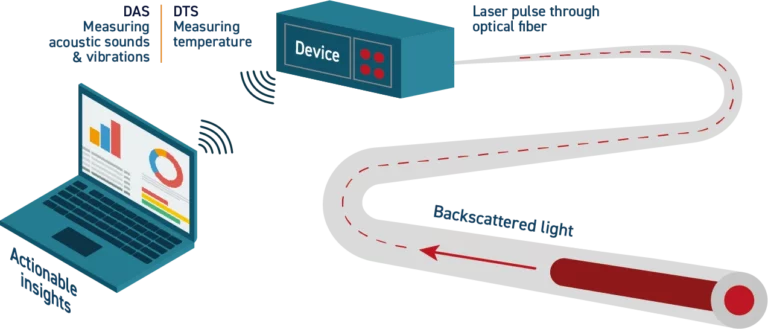Fiber optic technology
State-of-the-art fiber optic monitoring solutions for offshore power cables.

About fiber optics
The unleashed power of fiber optic technology.
Traditionally seen, fiber optic technology already plays a crucial role in the offshore wind and submarine power cable industry as it is a key component in the communication and transmission of power generated by wind turbines. By transmitting data at high speeds and over long distances, it enables real-time monitoring and control of undersea cables, improving reliability and safety. Submarine power cables DTS and DAS technology also relies on fiber optics to transmit data about the temperature performance or vibration of the cable.
Roadmap
Discover how we go from technology to insights.
State-of-the-art fiber optic monitoring solutions for offshore power cables.
1.
Connect fiber optic to DTS or DAS device.
Connecting fiber optic cables that are embedded in the submarine power cable to Distributed Temperature Sensing (DTS) or Distributed Acoustic Sensing (DAS) devices allows for real-time monitoring of various parameters in offshore wind farms, such as temperature, strain, and vibration. This ensures continuous and reliable data collection, enabling prompt detection of potential issues and allowing for preventive maintenance, resulting in reduced downtime and increased operational efficiency.
2.
Laser pulses sent through fiber optic cable.
Laser pulses from the DTS or DAS device are sent through the fiber optic cables. The pulses of light travel through the cable's core, which is made of glass or plastic, reflecting off the walls as they go.
3.
Spectrum of backscattered light.
The spectrum of backscattered light is a key aspect of fiber optic technology. By analyzing the spectrum of the light that is reflected back through the fiber, it is possible to detect changes and disturbances in the cable.
4.
DTS or DAS device gathers huge amount of raw data which is kept on servers.
All data that we directly obtain from the DTS or DAS devices is called raw data. This is data from the source and simply a dump of data in which there is no structure. Especially in view of DAS monitoring, the amount of raw data can increase quickly. The first thing we do is extract the raw dump of data and identify the important information that we need to develop our software with, as to store only relevant data on the servers.
5.
Get insights via our dashboard or individual reports.
Once you have collected data from your fiber optic monitoring system, it's important to be able to make sense of it. With our dashboard and individual reports, you can easily view and analyze the data collected from your fiber optic sensors. It is even possible to connect to you SCADA system or monitoring platform. The dashboard provides a high-level overview of the status of your infrastructure, while the individual reports offer more detailed insights into specific aspects of the monitoring data. And all of this with zero downtime.
SUBMARINE CABLE MONITORING SERVICES
Discover our other Marlinks monitoring services.
Marlinks guards your offshore power cables and empowers you to take monitoring to a whole new level and puts all this data, analytics and insights at your team’s fingertip. Enable your organization to keep risk low and save costs by making the right decisions.
Contact us.
Do you have questions about our offshore power cable services or other Marlinks-related questions?